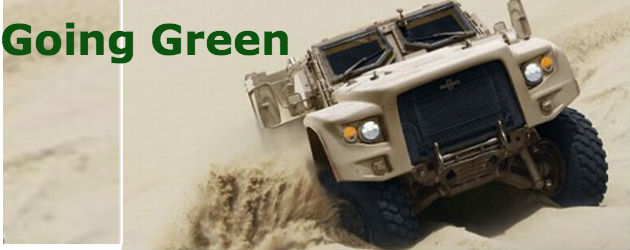U.S. Army Makes Progress on Vehicle Fleet Efficiency
 Courtesy of Triple Pundit, by Tina Casey: As the owner of the largest fleet of vehicles in the world, the U.S. Department of Defense is in a powerful position to promote new technologies that reduce greenhouse gas emissions and save energy.
Courtesy of Triple Pundit, by Tina Casey: As the owner of the largest fleet of vehicles in the world, the U.S. Department of Defense is in a powerful position to promote new technologies that reduce greenhouse gas emissions and save energy.
The Army, in particular, has an broad array of projects and programs under way to improve its ground vehicle fleet efficiency.
Many of the most promising projects are still in the development phase, so it will be a while before civilian fleet owners can get their hands on cutting-edge, high-performance vehicles with roots in military research. However, at a recent appearance at the Washington Auto Show, Katherine Hammack, Assistant Secretary of the Army for Installations, Energy and Environment, offered some insights into new Army fuel-saving strategies that could be applied to commercial vehicle fleets, new technology or not.
The Army and clean fleets
While the Army is also working on more efficient combat vehicles, the more immediate focus is on its fleet of more than 82,000 non-tactical vehicles. That includes passenger vehicles of all types, tractors and other wheeled equipment, and specialty vehicles such as fire trucks.
One good example of the Army’s long-term, high-payoff efforts is a pilot project for fuel cell vehicles underway in Hawaii, in partnership with GM. Though it consists of only 16 vehicles, the project will have far-ranging implications for civilian fleets.
The basic technology is not groundbreaking, but right now the range of fuel cell vehicles is limited by the scarcity of opportunities to re-fuel, so one major goal of the pilot project is to develop the fuel cell re-fueling infrastructure in Hawaii as a step toward more widespread adoption.
The project also aims squarely at overcoming one obstacle to hydrogen fuel cells, which is the amount of energy needed to manufacture hydrogen. The Hawaii project will focus on using renewable solar energy instead of petroleum fuel.
At TARDEC, the Army’s vehicle research center in Michigan, an entire new laboratory opened in 2012 to develop new vehicle energy technologies, including electric vehicles and advanced batteries as well as fuel cells.
Other areas of exploration include advanced materials for structural components and tires, engine efficiency, and fuel-saving drive and braking systems.
New strategies for Army fuel efficiency
Aside from pilot projects, the Army is in pretty much the same position as civilian fleet owners, which is to make due with whatever resources are already at hand.
That means, in part, buying or leasing smaller, more efficient vehicles and more alternative fuel vehicles as they become available. Leasing could be especially useful given how quickly new, more efficient technology is cycling into the commercial market, and that’s the tack that the Army has generally taken.
Another strategy is to keep fleet efficiency broadly focused on the operation as a whole, rather than concentrating only buying the latest technology.
That can mean setting priorities, as the Army has done by focusing first on the relatively low-hanging fruit of improving efficiency in the non-tactical part of its fleet.
That can also mean doing a better job of matching vehicle types with their usage. Hammack brought up the example of transportation around Army training ranges, which can consume a significant amount of fuel.
Until recently, gas guzzling Humvees were the vehicle of choice, though they are clearly not necessary for this kind of task. The Army saved a significant amount of fuel simply by switching to lighter, more efficient vehicles for training range transportation.
Another angle the Army has looked at is the elimination or consolidation of underused vehicles, for example by replacing individual cars with shuttle buses at bases. In addition to saving fuel, that strategy could have a significant impact on maintenance, repair and replacement costs.
None of this is happening by accident, by the way. According to Army writer David Verdun, a systematic push for greater fuel efficiency began in 2008. It accelerated in 2011, when President Obama issued a formal memorandum pledging all federal fleets to improve efficiency and performance.
To help share new strategies and information about fleet efficiency in the civilian sector, in 2011 the Obama Administration kicked off an initiative called Clean Fleets with major industry partners AT&T, FedEx, PepsiCo, UPS and Verizon.
It’s also worth noting that vehicle efficiency is just one element in a much broader future energy strategy for the Army. Like the other branches of the armed services, the Army is also focusing on LEED building standards and renewable energy installations, including solar and geothermal.
Category: Fleet Maintenance, General Update, Management










